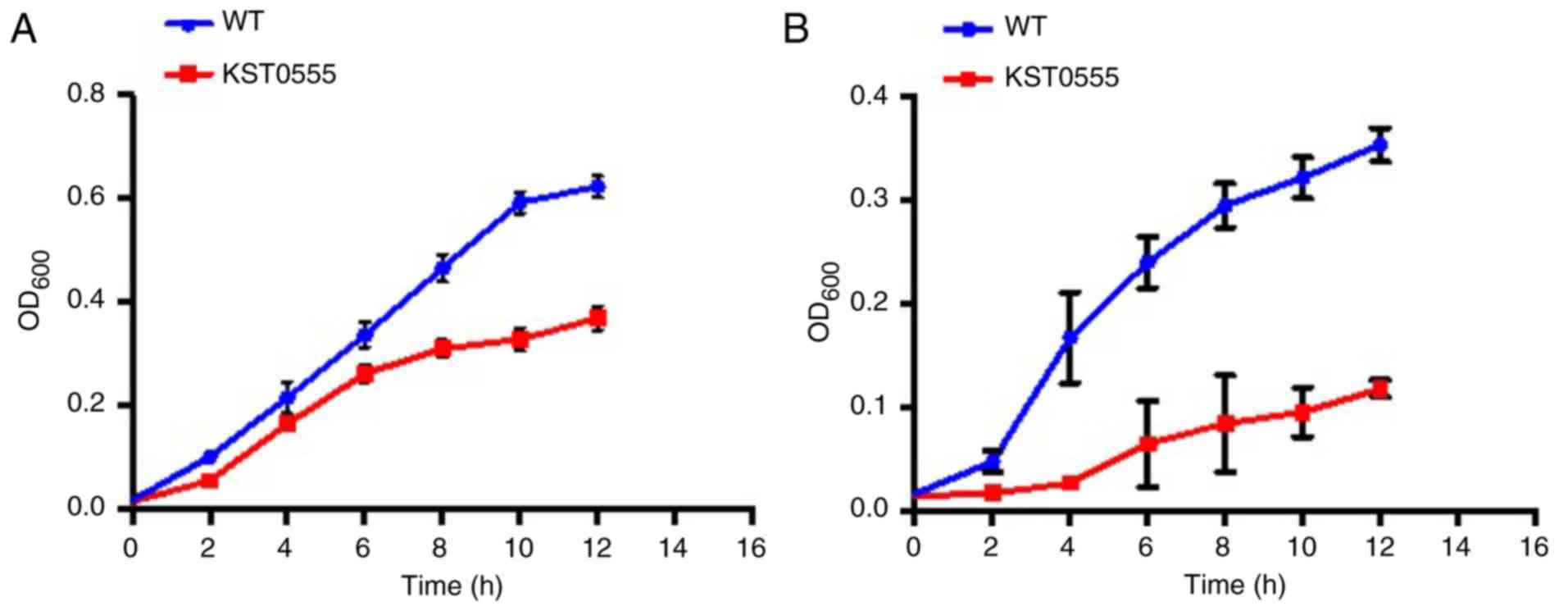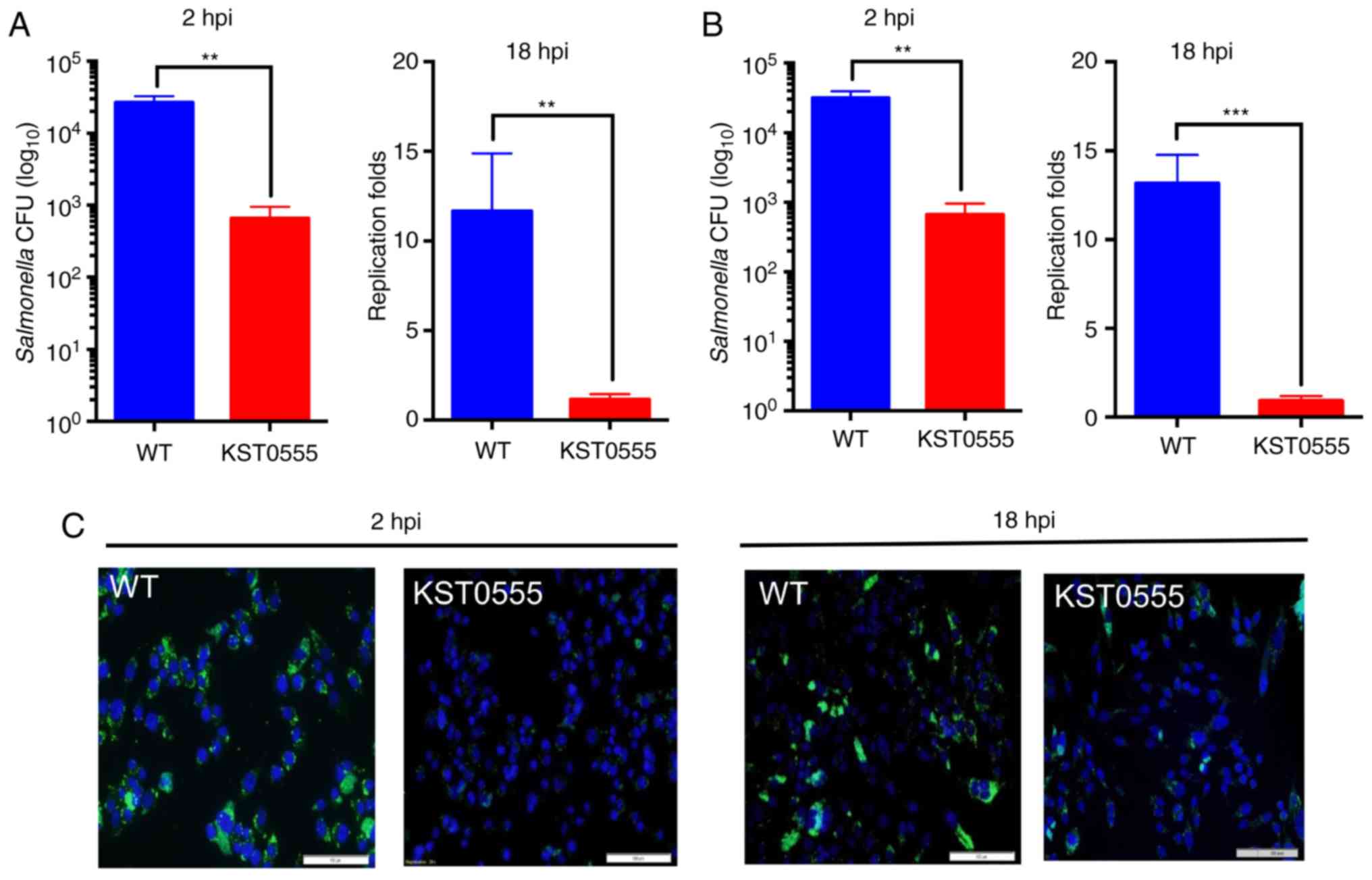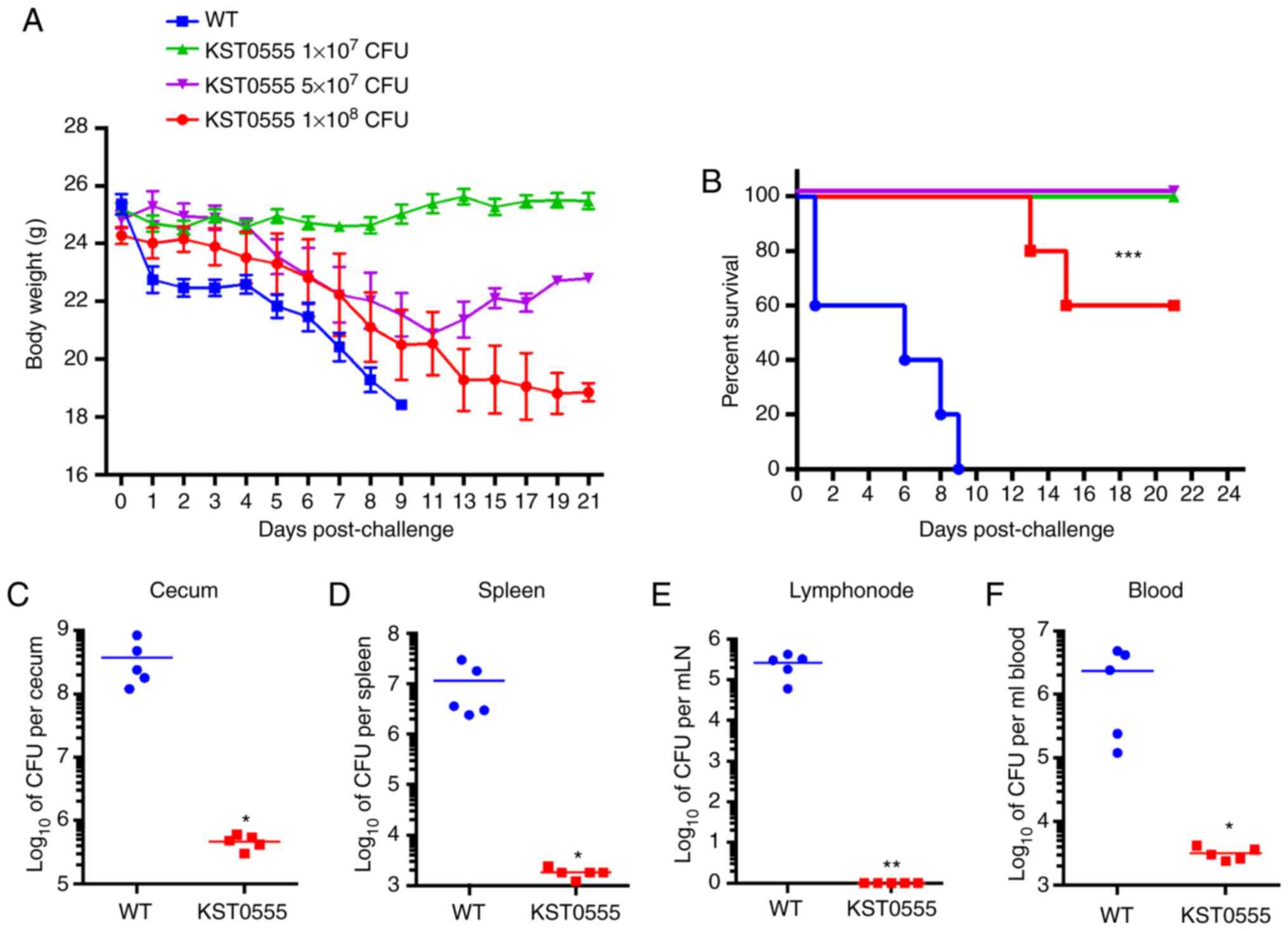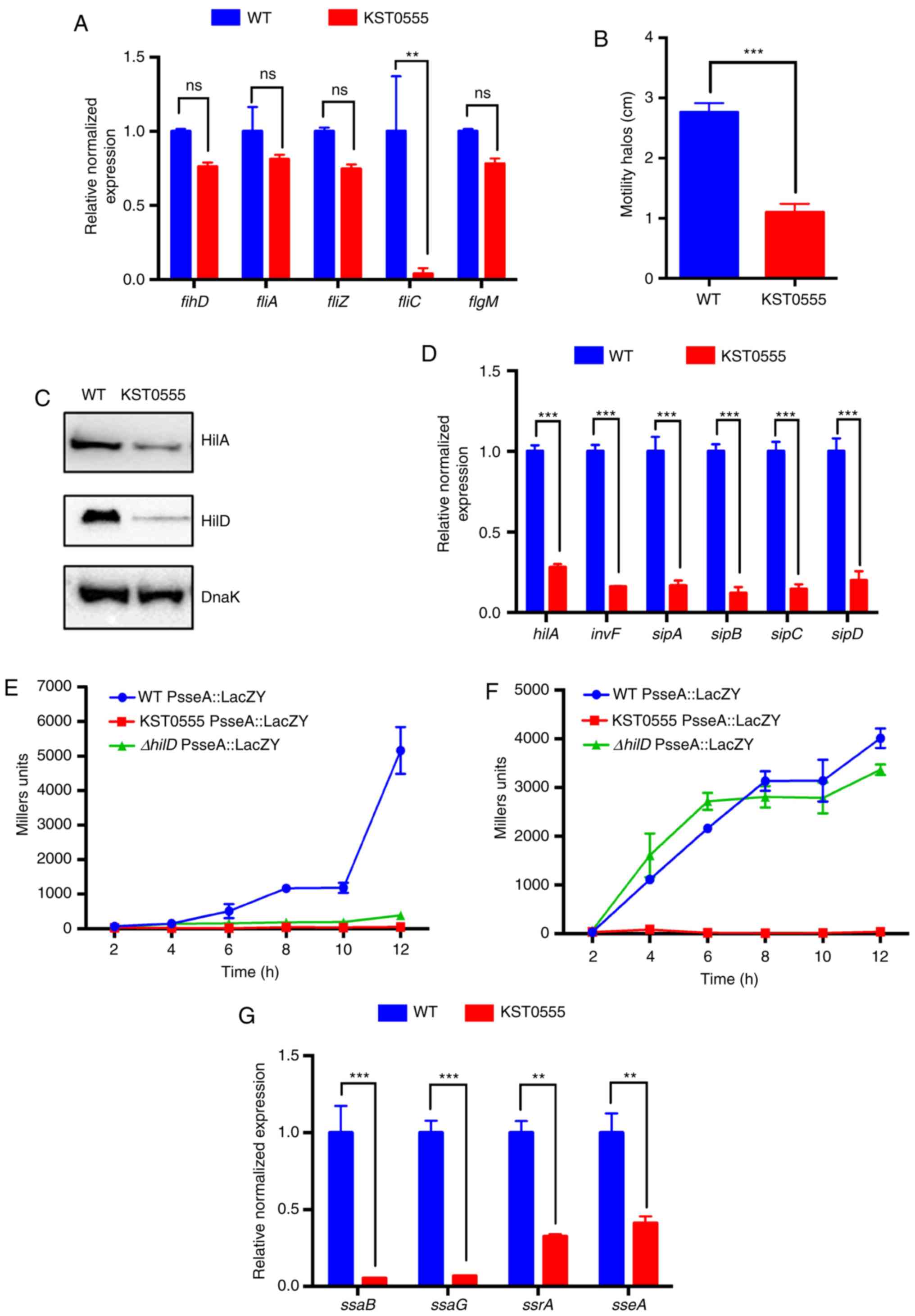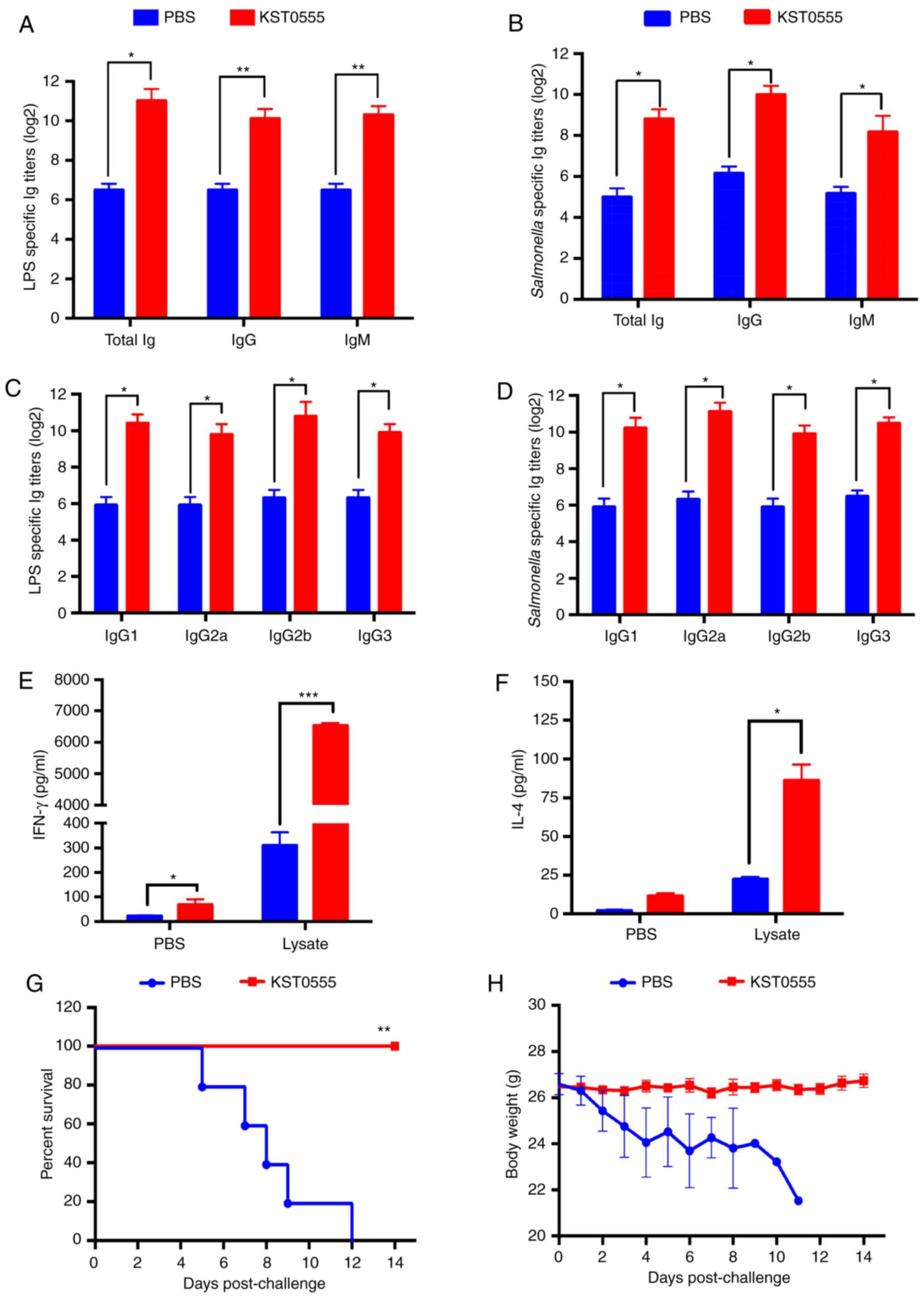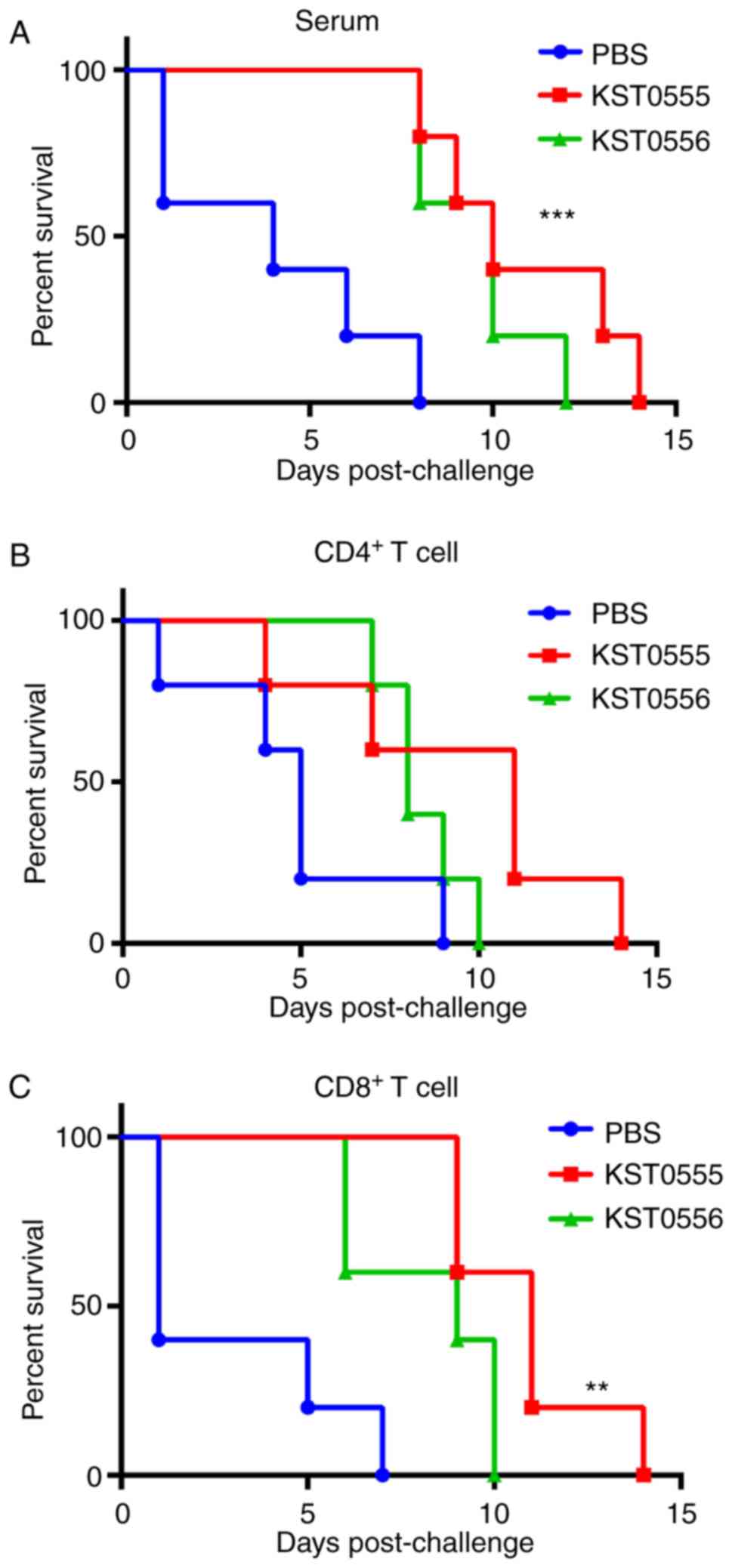|
1
|
Abed N, Grepinet O, Canepa S,
Hurtado-Escobar GA, Guichard N, Wiedemann A, Velge P and
Virlogeux-Payant I: Direct regulation of the pefI-srgC operon
encoding the Rck invasin by the quorum-sensing regulator SdiA in
Salmonella Typhimurium. Mol Microbiol. 94:254–271. 2014. View Article : Google Scholar : PubMed/NCBI
|
|
2
|
Febriani Y, Levallois P, Gingras S,
Gosselin P, Majowicz SE and Fleury MD: The association between
farming activities, precipitation, and the risk of acute
gastrointestinal illness in rural municipalities of Quebec, Canada:
A cross-sectional study. BMC Public Health. 10:482010. View Article : Google Scholar : PubMed/NCBI
|
|
3
|
Ao TT, Feasey NA, Gordon MA, Keddy KH,
Angulo FJ and Crump JA: Global burden of invasive nontyphoidal
Salmonella disease, 2010(1). Emerg Infect Dis. 21:2015. View Article : Google Scholar : PubMed/NCBI
|
|
4
|
Feasey NA, Dougan G, Kingsley RA,
Heyderman RS and Gordon MA: Invasive non-typhoidal Salmonella
disease: An emerging and neglected tropical disease in Africa.
Lancet. 379:2489–2499. 2012. View Article : Google Scholar : PubMed/NCBI
|
|
5
|
Crump JA, Sjolund-Karlsson M, Gordon MA
and Parry CM: Epidemiology, clinical presentation, laboratory
diagnosis, anti-microbial resistance, and antimicrobial management
of invasive Salmonella infections. Clin Microbiol Rev. 28:901–937.
2015. View Article : Google Scholar : PubMed/NCBI
|
|
6
|
Zansky S, Wallace B, Schoonmaker-Bopp D,
Smith P, Ramsey F, Painter J, Gupta A, Kalluri P and Noviello S:
From the centers for disease control and prevention. Outbreak of
multi-drug resistant Salmonella Newport-United States,
January–April 2002. JAMA. 288:951–953. 2002.PubMed/NCBI
|
|
7
|
Strugnell RA, Scott TA, Wang N, Yang C,
Peres N, Bedoui S and Kupz A: Salmonella vaccines: Lessons from the
mouse model or bad teaching? Curr Opin Microbiol. 17:99–105. 2014.
View Article : Google Scholar : PubMed/NCBI
|
|
8
|
Typhoid vaccines: WHO position paper. Wkly
Epidemiol Rec. 83:49–59. 2008.(In English, Finnish). PubMed/NCBI
|
|
9
|
DeRoeck D, Ochiai RL, Yang J, Anh DD, Alag
V and Clemens JD: Typhoid vaccination: The Asian experience. Expert
Rev Vaccines. 7:547–560. 2008. View Article : Google Scholar : PubMed/NCBI
|
|
10
|
DeRoeck D, Clemens JD, Nyamete A and
Mahoney RT: Policymakers’ views regarding the introduction of
new-generation vaccines against typhoid fever, shigellosis and
cholera in Asia. Vaccine. 23:2762–2774. 2005. View Article : Google Scholar : PubMed/NCBI
|
|
11
|
Kantele A, Pakkanen SH, Siitonen A,
Karttunen R and Kantele JM: Live oral typhoid vaccine Salmonella
Typhi Ty21a-a surrogate vaccine against non-typhoid salmonella?
Vaccine. 30:7238–7245. 2012. View Article : Google Scholar : PubMed/NCBI
|
|
12
|
Watson DC, Robbins JB and Szu SC:
Protection of mice against Salmonella typhimurium with an
O-specific polysaccharide-protein conjugate vaccine. Infect Immun.
60:4679–4686. 1992. View Article : Google Scholar : PubMed/NCBI
|
|
13
|
Gerke C, Colucci AM, Giannelli C, Sanzone
S, Vitali CG, Sollai L, Rossi O, Martin LB, Auerbach J, Di Cioccio
V and Saul A: Production of a shigella sonnei vaccine based on
generalized modules for membrane antigens (GMMA), 1790GAHB. PLoS
One. 10:e01344782015. View Article : Google Scholar : PubMed/NCBI
|
|
14
|
Secundino I, Lopez-Macias C,
Cervantes-Barragan L, Gil-Cruz C, Ríos-Sarabia N, Pastelin-Palacios
R, Villasis-Keever MA, Becker I, Puente JL, Calva E and Isibasi A:
Salmonella porins induce a sustained, lifelong specific
bactericidal antibody memory response. Immunology. 117:59–70. 2006.
View Article : Google Scholar : PubMed/NCBI
|
|
15
|
Kodama C and Matsui H: Salmonella
flagellin is not a dominant protective antigen in oral immunization
with attenuated live vaccine strains. Infect Immun. 72:2449–2451.
2004. View Article : Google Scholar : PubMed/NCBI
|
|
16
|
Gil-Cruz C, Bobat S, Marshall JL, Kingsley
RA, Ross EA, Henderson IR, Leyton DL, Coughlan RE, Khan M, Jensen
KT, et al: The porin OmpD from nontyphoidal Salmonella is a key
target for a protective B1b cell antibody response. Proc Natl Acad
Sci USA. 106:9803–9808. 2009. View Article : Google Scholar : PubMed/NCBI
|
|
17
|
Sette A and Rappuoli R: Reverse
vaccinology: Developing vaccines in the era of genomics. Immunity.
33:530–541. 2010. View Article : Google Scholar : PubMed/NCBI
|
|
18
|
Salazar-Gonzalez RM, Maldonado-Bernal C,
Ramirez-Cruz NE, Rios-Sarabia N, Beltrán-Nava J, Castañón-González
J, Castillo-Torres N, Palma-Aguirre JA, Carrera-Camargo M,
López-Macías C and Isibasi A: Induction of cellular immune response
and anti-Salmonella enterica serovar typhi bactericidal antibodies
in healthy volunteers by immunization with a vaccine candidate
against typhoid fever. Immunol Lett. 93:115–122. 2004. View Article : Google Scholar : PubMed/NCBI
|
|
19
|
Hodak H and Galan JE: A Salmonella typhi
homologue of bacteriophage muramidases controls typhoid toxin
secretion. EMBO Rep. 14:95–102. 2013. View Article : Google Scholar :
|
|
20
|
MacLennan CA, Martin LB and Micoli F:
Vaccines against invasive Salmonella disease: Current status and
future directions. Hum Vaccin Immunother. 10:1478–1493. 2014.
View Article : Google Scholar : PubMed/NCBI
|
|
21
|
Tennant SM and Levine MM: Live attenuated
vaccines for invasive Salmonella infections. Vaccine. 33(Suppl 3):
C36–C41. 2015. View Article : Google Scholar : PubMed/NCBI
|
|
22
|
Tennant SM, Wang JY, Galen JE, Simon R,
Pasetti MF, Gat O and Levine MM: Engineering and preclinical
evaluation of attenuated nontyphoidal Salmonella strains serving as
live oral vaccines and as reagent strains. Infect Immun.
79:4175–4185. 2011. View Article : Google Scholar : PubMed/NCBI
|
|
23
|
Tacket CO, Sztein MB, Losonsky GA,
Wasserman SS, Nataro JP, Edelman R, Pickard D, Dougan G, Chatfield
SN and Levine MM: Safety of live oral Salmonella typhi vaccine
strains with deletions in htrA and aroC aroD and immune response in
humans. Infect Immun. 65:452–456. 1997. View Article : Google Scholar : PubMed/NCBI
|
|
24
|
Angelakopoulos H and Hohmann EL: Pilot
study of phoP/phoQ-deleted Salmonella enterica serovar typhimurium
expressing Helicobacter pylori urease in adult volunteers. Infect
Immun. 68:2135–2141. 2000. View Article : Google Scholar : PubMed/NCBI
|
|
25
|
Tran TH, Nguyen TD, Nguyen TT, Ninh TT,
Tran NB, Nguyen VM, Tran TT, Cao TT, Pham VM, Nguyen TC, et al: A
randomised trial evaluating the safety and immunogenicity of the
novel single oral dose typhoid vaccine M01ZH09 in healthy
Vietnamese children. PLoS One. 5:e117782010. View Article : Google Scholar : PubMed/NCBI
|
|
26
|
Lyon CE, Sadigh KS, Carmolli MP, Harro C,
Sheldon E, Lindow JC, Larsson CJ, Martinez T, Feller A, Ventrone
CH, et al: In a randomized, double-blinded, placebo-controlled
trial, the single oral dose typhoid vaccine, M01ZH09, is safe and
immunogenic at doses up to 1.7 × 10(10) colony-forming units.
Vaccine. 28:3602–3608. 2010. View Article : Google Scholar : PubMed/NCBI
|
|
27
|
Ault A, Tennant SM, Gorres JP, Eckhaus M,
Sandler NG, Roque A, Livio S, Bao S, Foulds KE, Kao SF, et al:
Safety and tolerability of a live oral Salmonella typhimurium
vaccine candidate in SIV-infected nonhuman primates. Vaccine.
31:5879–5888. 2013. View Article : Google Scholar : PubMed/NCBI
|
|
28
|
Eisenreich W, Dandekar T, Heesemann J and
Goebel W: Carbon metabolism of intracellular bacterial pathogens
and possible links to virulence. Nat Rev Microbiol. 8:401–412.
2010. View Article : Google Scholar : PubMed/NCBI
|
|
29
|
Abrahams GL and Hensel M: Manipulating
cellular transport and immune responses: Dynamic interactions
between intracellular Salmonella enterica and its host cells. Cell
Microbiol. 8:728–737. 2006. View Article : Google Scholar : PubMed/NCBI
|
|
30
|
Bowden SD, Rowley G, Hinton JC and
Thompson A: Glucose and glycolysis are required for the successful
infection of macrophages and mice by Salmonella enterica serovar
typhimurium. Infect Immun. 77:3117–3126. 2009. View Article : Google Scholar : PubMed/NCBI
|
|
31
|
Klose KE and Mekalanos JJ: Simultaneous
prevention of glutamine synthesis and high-affinity transport
attenuates Salmonella typhimurium virulence. Infect Immun.
65:587–596. 1997. View Article : Google Scholar : PubMed/NCBI
|
|
32
|
Postma PW, Lengeler JW and Jacobson GR:
Phosphoenolpy ruvate:Carbohydrate phosphotransferase systems of
bacteria. Microbiol Rev. 57:543–594. 1993. View Article : Google Scholar : PubMed/NCBI
|
|
33
|
Deutscher J, Francke C and Postma PW: How
phosphotransferase system-related protein phosphorylation regulates
carbohydrate metabolism in bacteria. Microbiol Mol Biol Rev.
70:939–1031. 2006. View Article : Google Scholar : PubMed/NCBI
|
|
34
|
Zhi Y, Lin SM, Jang AY, Ahn KB, Ji HJ, Guo
HC, Lim S and Seo HS: Effective mucosal live attenuated Salmonella
vaccine by deleting phosphotransferase system component genes ptsI
and crr. J Microbiol. 57:64–73. 2019. View Article : Google Scholar
|
|
35
|
Maze A, Glatter T and Bumann D: The
central metabolism regulator EIIAGlc switches Salmonella from
growth arrest to acute virulence through activation of virulence
factor secretion. Cell Rep. 7:1426–1433. 2014. View Article : Google Scholar : PubMed/NCBI
|
|
36
|
Luo Y, Kong Q, Yang J, Golden G, Wanda SY,
Jensen RV, Ernst PB and Curtiss R III: Complete genome sequence of
the universal killer Salmonella enterica serovar typhimurium UK-1
(ATCC 68169). J Bacteriol. 193:4035–4036. 2011. View Article : Google Scholar : PubMed/NCBI
|
|
37
|
Datsenko KA and Wanner BL: One-step
inactivation of chromosomal genes in Escherichia coli K-12 using
PCR products. Proc Natl Acad Sci USA. 97:6640–6645. 2000.
View Article : Google Scholar : PubMed/NCBI
|
|
38
|
Ebel-Tsipis J, Fox MS and Botstein D:
Generalized transduction by bacteriophage P22 in Salmonella
typhimurium. II. Mechanism of integration of transducing DNA. J Mol
Boil. 71:449–469. 1972. View Article : Google Scholar
|
|
39
|
Davis RW, Botstein D and Roth JR: Advanced
Bacterial Genetics. Cold Spring Harbor Laboratory; Cold Spring
Harbor, NY: 1980
|
|
40
|
Miller JH: Experiments in molecular
genetics. Cold Spring Harbor Laboratory; Cold Spring Harbor, NY:
1972
|
|
41
|
Coombes BK, Coburn BA, Potter AA, Gomis S,
Mirakhur K, Li Y and Finlay BB: Analysis of the contribution of
Salmonella pathogenicity islands 1 and 2 to enteric disease
progression using a novel bovine ileal loop model and a murine
model of infectious enterocolitis. Infect Immun. 73:7161–7169.
2005. View Article : Google Scholar : PubMed/NCBI
|
|
42
|
Yu XJ, McGourty K, Liu M, Unsworth KE and
Holden DW: pH sensing by intracellular Salmonella induces effector
translocation. Science. 328:1040–1043. 2010. View Article : Google Scholar : PubMed/NCBI
|
|
43
|
Livak KJ and Schmittgen TD: Analysis of
relative gene expression data using real-time quantitative PCR and
the 2(−D elta Delta C(T)) method. Methods. 25:402–408. 2001.
View Article : Google Scholar
|
|
44
|
Kim W and Surette MG: Swarming populations
of Salmonella represent a unique physiological state coupled to
multiple mechanisms of antibiotic resistance. Biol Proced Online.
5:189–196. 2003. View
Article : Google Scholar : PubMed/NCBI
|
|
45
|
Nishikawa F, Kita E, Matsui N and Kashiba
S: Transfer of protection to murine typhoid conferred by L-form
Salmonella typhimurium in dependence of cooperation between L
form-adopted macrophages and L form-induced Lyt-2+ T
cells. Microbiol Immunol. 38:201–207. 1994. View Article : Google Scholar
|
|
46
|
Meyerholz DK and Stabel TJ: Comparison of
early ileal invasion by Salmonella enterica serovars choleraesuis
and typhimurium. Vet Pathol. 40:371–375. 2003. View Article : Google Scholar : PubMed/NCBI
|
|
47
|
Haque A, Bowe F, Fitzhenry RJ, Frankel G,
Thomson M, Heuschkel R, Murch S, Stevens MP, Wallis TS, Phillips AD
and Dougan G: Early interactions of Salmonella enterica serovar
typhimurium with human small intestinal epithelial explants. Gut.
53:1424–1430. 2004. View Article : Google Scholar : PubMed/NCBI
|
|
48
|
Tierrez A and Garcia-del Portillo F: New
concepts in Salmonella virulence: The importance of reducing the
intracellular growth rate in the host. Cell Microbiol. 7:901–909.
2005. View Article : Google Scholar : PubMed/NCBI
|
|
49
|
Marcus SL, Brumell JH, Pfeifer CG and
Finlay BB: Salmonella pathogenicity islands: Big virulence in small
packages. Microbes Infect. 2:145–156. 2000. View Article : Google Scholar : PubMed/NCBI
|
|
50
|
Hensel M: Salmonella pathogenicity island
2. Mol Microbiol. 36:1015–1023. 2000. View Article : Google Scholar : PubMed/NCBI
|
|
51
|
Lostroh CP and Lee CA: The HilA box and
sequences outside it determine the magnitude of HilA-dependent
activation of P(prgH) from Salmonella pathogenicity island 1. J
Bacteriol. 183:4876–4885. 2001. View Article : Google Scholar : PubMed/NCBI
|
|
52
|
Bustamante VH, Martinez LC, Santana FJ,
Knodler LA, Steele-Mortimer O and Puente JL: HilD-mediated
transcriptional cross-talk between SPI-1 and SPI-2. Proc Natl Acad
Sci USA. 105:14591–14596. 2008. View Article : Google Scholar : PubMed/NCBI
|
|
53
|
Haselbeck AH, Panzner U, Im J, Baker S,
Meyer CG and Marks F: Current perspectives on invasive nontyphoidal
Salmonella disease. Curr Opin Infect Dis. 30:498–503. 2017.
View Article : Google Scholar : PubMed/NCBI
|
|
54
|
Darji A, zur Lage S, Garbe AI, Chakraborty
T and Weiss S: Oral delivery of DNA vaccines using attenuated
Salmonella typhimurium as carrier. FEMS Immunol Med Microbiol.
27:341–349. 2000. View Article : Google Scholar : PubMed/NCBI
|
|
55
|
Levine MM, Ferreccio C, Abrego P, Martin
OS, Ortiz E and Cryz S: Duration of efficacy of Ty21a, attenuated
Salmonella typhi live oral vaccine. Vaccine. 17(Suppl 2): S22–S27.
1999. View Article : Google Scholar : PubMed/NCBI
|
|
56
|
Hoiseth SK and Stocker BA:
Aromatic-dependent Salmonella typhimurium are non-virulent and
effective as live vaccines. Nature. 291:238–239. 1981. View Article : Google Scholar : PubMed/NCBI
|
|
57
|
Pasquali P, Ammendola S, Pistoia C,
Petrucci P, Tarantino M, Valente C, Marenzoni ML, Rotilio G and
Battistoni A: Attenuated Salmonella enterica serovar Typhimurium
lacking the ZnuABC transporter confers immune-based protection
against challenge infections in mice. Vaccine. 26:3421–3426. 2008.
View Article : Google Scholar : PubMed/NCBI
|
|
58
|
Pesciaroli M, Aloisio F, Ammendola S,
Pistoia C, Petrucci P, Tarantino M, Francia M, Battistoni A and
Pasquali P: An attenuated Salmonella enterica serovar Typhimurium
strain lacking the ZnuABC transporter induces protection in a mouse
intestinal model of Salmonella infection. Vaccine. 29:1783–1790.
2011. View Article : Google Scholar : PubMed/NCBI
|
|
59
|
Gradassi M, Pesciaroli M, Martinelli N,
Ruggeri J, Petrucci P, Hassan WH, Raffatellu M, Scaglione FE,
Ammendola S, Battistoni A, et al: Attenuated Salmonella enterica
serovar Typhimurium lacking the ZnuABC transporter: An efficacious
orally-administered mucosal vaccine against salmonellosis in pigs.
Vaccine. 31:3695–3701. 2013. View Article : Google Scholar : PubMed/NCBI
|
|
60
|
Pesciaroli M, Gradassi M, Martinelli N,
Ruggeri J, Pistoia C, Raffatellu M, Magistrali CF, Battistoni A,
Pasquali P and Alborali GL: Salmonella Typhimurium lacking the
Znuabc transporter is attenuated and immunogenic in pigs. Vaccine.
31:2868–2873. 2013. View Article : Google Scholar : PubMed/NCBI
|
|
61
|
Sittka A, Pfeiffer V, Tedin K and Vogel J:
The RNA chaperone Hfq is essential for the virulence of Salmonella
typhimurium. Mol Microbiol. 63:193–217. 2007. View Article : Google Scholar :
|
|
62
|
Lopez-Garrido J and Casadesus J:
Regulation of Salmonella enterica pathogenicity island 1 by DNA
adenine methylation. Genetics. 184:637–649. 2010. View Article : Google Scholar :
|
|
63
|
Hindle Z, Chatfield SN, Phillimore J,
Bentley M, Johnson J, Cosgrove CA, Ghaem-Maghami M, Sexton A, Khan
M, Brennan FR, et al: Characterization of Salmonella enterica
derivatives harboring defined aroC and Salmonella pathogenicity
island 2 type III secretion system (ssaV) mutations by immunization
of healthy volunteers. Infect Immun. 70:3457–3467. 2002. View Article : Google Scholar : PubMed/NCBI
|
|
64
|
Hansen-Wester I and Hensel M: Salmonella
pathogenicity islands encoding type III secretion systems. Microbes
Infect. 3:549–559. 2001. View Article : Google Scholar : PubMed/NCBI
|
|
65
|
Le Bouguenec C and Schouler C: Sugar
metabolism, an additional virulence factor in enterobacteria. Int J
Med Microbiol. 301:1–6. 2011. View Article : Google Scholar
|
|
66
|
Wilharm G and Heider C: Interrelationship
between type three secretion system and metabolism in pathogenic
bacteria. Front Cell Infect Microbiol. 4:1502014. View Article : Google Scholar : PubMed/NCBI
|
|
67
|
Teplitski M, Goodier RI and Ahmer BM:
Catabolite repression of the SirA regulatory cascade in Salmonella
enterica. Int J Med Microbiol. 296:449–466. 2006. View Article : Google Scholar : PubMed/NCBI
|
|
68
|
Martinez LC, Yakhnin H, Camacho MI,
Georgellis D, Babitzke P, Puente JL and Bustamante VH: Integration
of a complex regulatory cascade involving the SirA/BarA and Csr
global regulatory systems that controls expression of the
Salmonella SPI-1 and SPI-2 virulence regulons through HilD. Mol
Microbiol. 80:1637–1656. 2011. View Article : Google Scholar : PubMed/NCBI
|
|
69
|
Poncet S, Milohanic E, Maze A, Abdallah
JN, Aké F, Larribe M, Deghmane AE, Taha MK, Dozot M, De Bolle X, et
al: Correlations between carbon metabolism and virulence in
bacteria. Contrib Microbiol. 16:88–102. 2009. View Article : Google Scholar : PubMed/NCBI
|
|
70
|
Stecher B, Hapfelmeier S, Muller C, Kremer
M, Stallmach T and Hardt WD: Flagella and chemotaxis are required
for efficient induction of Salmonella enterica serovar Typhimurium
colitis in streptomycin-pretreated mice. Infect Immun.
72:4138–4150. 2004. View Article : Google Scholar : PubMed/NCBI
|
|
71
|
Stecher B, Barthel M, Schlumberger MC,
Haberli L, Rabsch W, Kremer M and Hardt WD: Motility allows S.
Typhimurium to benefit from the mucosal defence. Cell Microbiol.
10:1166–1180. 2008. View Article : Google Scholar : PubMed/NCBI
|
|
72
|
Lim S, Han A, Kim D and Seo HS:
Transcriptional profiling of an attenuated Salmonella Typhimurium
ptsI mutant strain under low-oxygen conditions using microarray
analysis. J Bacteriol Virol. 45:1–15. 2015. View Article : Google Scholar
|
|
73
|
Lim S, Kim M, Choi J and Ryu S: A mutation
in tdcA attenuates the virulence of Salmonella enterica serovar
Typhimurium. Mol Cells. 29:509–517. 2010. View Article : Google Scholar : PubMed/NCBI
|
|
74
|
Baba T, Ara T, Hasegawa M, Takai Y,
Okumura Y, Baba M, Datsenko KA, Tomita M, Wanner BL and Mori H:
Construction of Escherichia coli K-12 in-frame, single-gene
knockout mutants: The Keio collection. Mol Syst Biol. 2:2006 0008.
2006. View Article : Google Scholar : PubMed/NCBI
|















